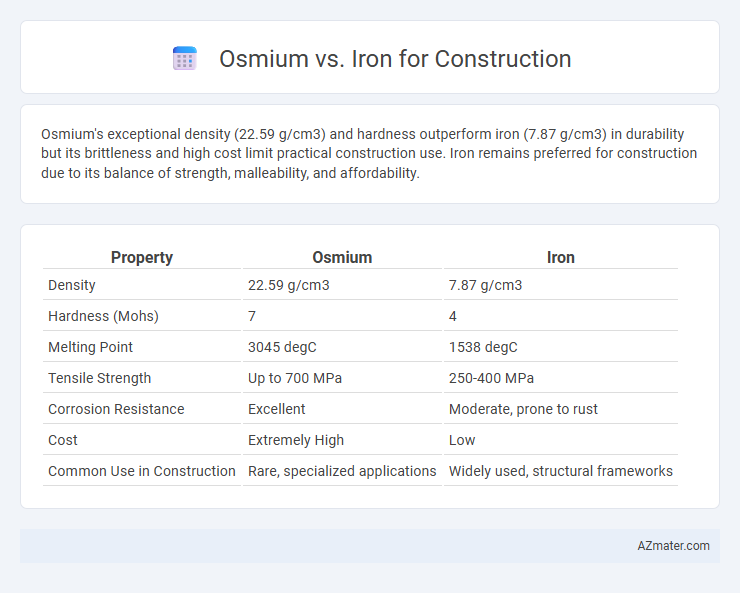Osmium's exceptional density (22.59 g/cm3) and hardness outperform iron (7.87 g/cm3) in durability but its brittleness and high cost limit practical construction use. Iron remains preferred for construction due to its balance of strength, malleability, and affordability.
Table of Comparison
| Property | Osmium | Iron |
|---|---|---|
| Density | 22.59 g/cm3 | 7.87 g/cm3 |
| Hardness (Mohs) | 7 | 4 |
| Melting Point | 3045 degC | 1538 degC |
| Tensile Strength | Up to 700 MPa | 250-400 MPa |
| Corrosion Resistance | Excellent | Moderate, prone to rust |
| Cost | Extremely High | Low |
| Common Use in Construction | Rare, specialized applications | Widely used, structural frameworks |
Introduction to Osmium and Iron in Construction
Osmium, a rare and dense transition metal with exceptional hardness and corrosion resistance, offers unique advantages for specialized construction applications requiring high durability and weight capacity. Iron, abundant and cost-effective, remains a fundamental material in construction due to its strength, versatility, and ease of alloying into steel for structural frameworks. Understanding the distinct properties and availability of osmium versus iron highlights their tailored use cases in modern construction engineering.
Material Properties: Osmium vs Iron
Osmium, with a density of 22.59 g/cm3, is significantly heavier and more brittle than iron, which has a density of 7.87 g/cm3 and excellent malleability. Iron's tensile strength and ductility make it ideal for structural frameworks, while osmium's hardness and high melting point of 3033degC limit its use primarily to specialized applications. Corrosion resistance favors iron alloys with protective treatments, whereas osmium's natural resistance to oxidation is advantageous but offset by cost and scarcity in construction contexts.
Strength and Durability Comparison
Osmium exhibits exceptional density and hardness, making it significantly stronger and more wear-resistant than iron; its tensile strength surpasses that of iron alloys commonly used in construction. Iron, specifically steel, is favored for construction due to its balanced combination of strength, ductility, and cost-effectiveness, while osmium's brittleness and high cost limit its practical application despite superior hardness. In durability, osmium's resistance to corrosion and wear is notably higher, but iron's malleability and ease of maintenance ensure its continued dominance in large-scale construction projects.
Corrosion Resistance in Building Environments
Osmium exhibits superior corrosion resistance compared to iron, making it highly valuable in building environments prone to oxidation and chemical exposure. Its dense, precious metal properties ensure minimal degradation over time, unlike iron, which readily oxidizes to form rust and requires protective coatings. This inherent durability makes osmium a potential niche material in corrosive environments where structural longevity is critical.
Weight and Density Differences
Osmium has a density of approximately 22.59 g/cm3, making it the densest naturally occurring element, whereas iron's density is about 7.87 g/cm3. This significant density difference means osmium is nearly three times heavier than iron for the same volume, presenting challenges in construction applications where weight is critical. While iron's lower density and excellent strength-to-weight ratio make it practical for structural frameworks, osmium's extreme weight limits its use to specialized, high-density requirements rather than general construction.
Cost and Economic Feasibility
Osmium's extreme rarity and high cost, exceeding $13,000 per ounce, make it economically unfeasible for large-scale construction compared to iron, which is abundant and costs roughly $0.10 per pound. Iron's cost-effectiveness and availability have established it as the primary material in construction, offering durability and structural integrity without prohibitive expenses. The prohibitive expense of osmium outweighs its physical advantages, rendering it impractical for typical construction applications.
Availability and Sourcing Issues
Osmium is extremely rare, with annual production measured in mere kilograms, making its availability for construction impractical compared to iron, which is the second most abundant metal in the Earth's crust and sourced extensively from large-scale mining operations worldwide. Iron's well-established supply chain and global mining infrastructure ensure consistent availability and relatively low cost, whereas osmium's scarcity and extraction from platinum-group metal ores pose significant sourcing challenges and high costs. The limited osmium supply and complex refinement processes restrict its use primarily to specialized applications rather than widespread construction materials.
Environmental Impact and Sustainability
Osmium, being one of the densest metals, has limited application in construction due to its rarity, high cost, and environmental impact associated with its extraction, which requires extensive energy use and generates significant mining waste. Iron, predominantly used in steel production, offers greater sustainability through widespread recycling and abundant availability, though its mining and smelting contribute to greenhouse gas emissions and habitat disruption. Advances in sustainable steel manufacturing and increased use of recycled iron significantly reduce environmental footprints compared to osmium's resource-intensive production.
Applications in Modern Construction
Osmium, known for its extreme density and hardness, is rarely used directly in construction due to its brittleness and high cost, making iron the preferred metal for structural applications. Iron, especially in the form of steel alloys, offers excellent strength, ductility, and cost-efficiency, making it essential in frameworks, reinforcements, and load-bearing structures in modern construction. Advances in iron alloy technology have optimized durability and resistance to corrosion, reinforcing its dominance over osmium in building infrastructure.
Future Prospects and Innovations
Osmium's exceptional density and hardness position it as a futuristic material for ultra-durable construction, though its rarity and cost limit widespread application compared to iron, which remains dominant due to affordability and proven versatility. Innovations in nanotechnology and alloy engineering could unlock osmium's potential by enhancing its machinability and reducing material usage through composite structures. Future construction trends may leverage osmium-infused materials for specialized applications requiring extreme wear resistance and longevity, while iron-based alloys continue to evolve with sustainable and high-strength properties for mass infrastructure development.

Infographic: Osmium vs Iron for Construction
 azmater.com
azmater.com